Echo BRUSHCUTTER User Manual
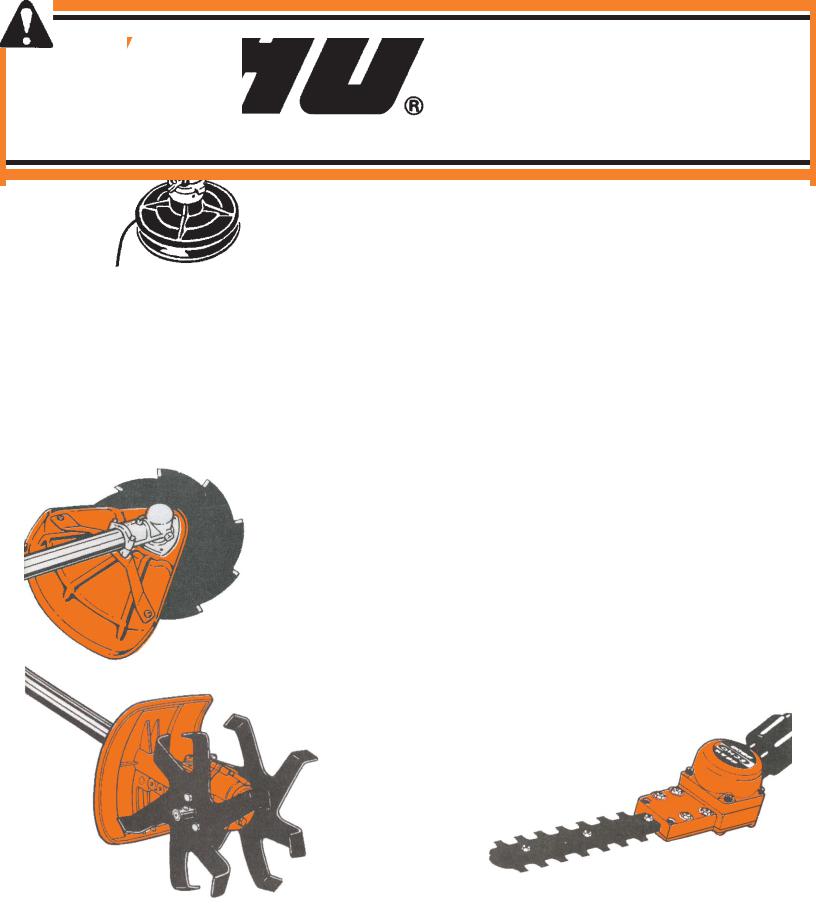
GRASS/WEED TRIMMER
BRUSHCUTTER and
CLEARING SAW
SAFETY MANUAL
Read and understand these instructions.
Failure to do so will increase risk of injury.
For your nearest ECHO Dealer, call 1-800-432-ECHO (3246)
X7522270400 |
99922202600 |
|
06/98
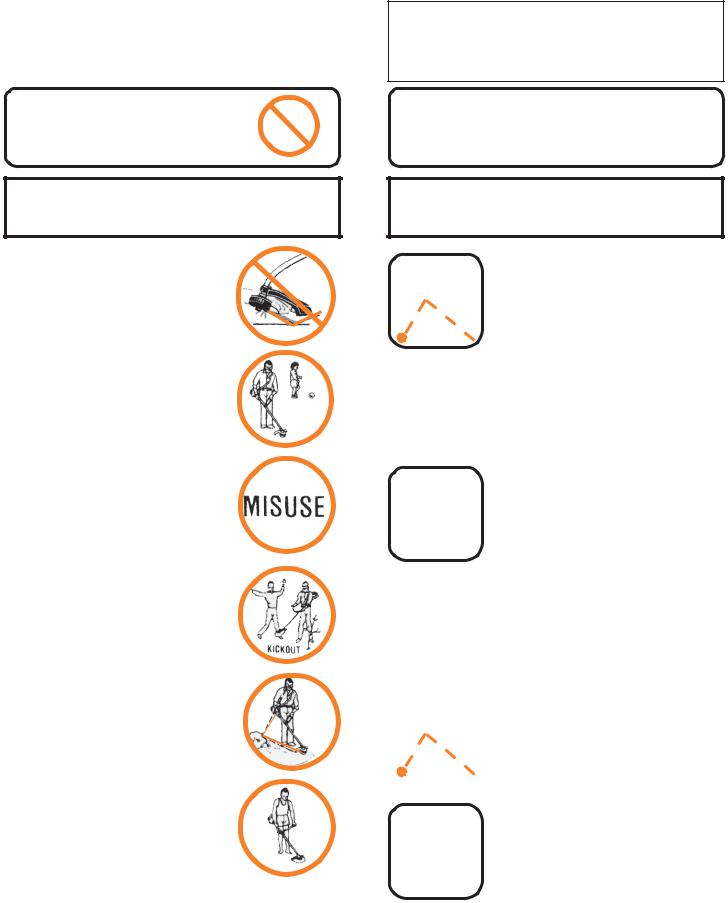
GRAPHIC WARNINGS
Circle and slash symbol means whatever is shown is prohibited.
Specifications, descriptions and illustrative material in this literature are as accurate as known at the time of publication, but are subject to change without notice. Illustrations may include optional equipment and accessories, and may not include all standard equipment.
This device accompanied by the words
WARNING and DANGER calls attention to an act or a condition which can lead to serious personal injury.
RISKS |
& |
|
|
Eye Loss from |
& |
Thrown Objects |
|
TO REDUCE RISKS
Wear Eye/Leg Protection
(ANSI Z87.1)
Injury to Bystanders
Injury
Blade Contact
from Kick Out (Blade Thrust)
Eye Loss from Ricochet
Using Wrong
Equipment
 &
&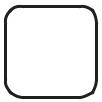
 &
& 
 &
&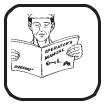
 &
&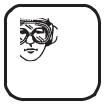
 &
& 
Keep People and
Animals Away
15 meters (50 feet)
Read & Understand
Operator’s Manual and
Safety Manual
•Read Manuals
•Proper Gear
•Keep People Away
Wear Eye/Leg Protection
(ANSI Z87.1)
Blade Operation
Requires:
• Blade Shield & Shoulder
Harness with Bar Handle or
U-Handle
Wear Proper Clothing.
2
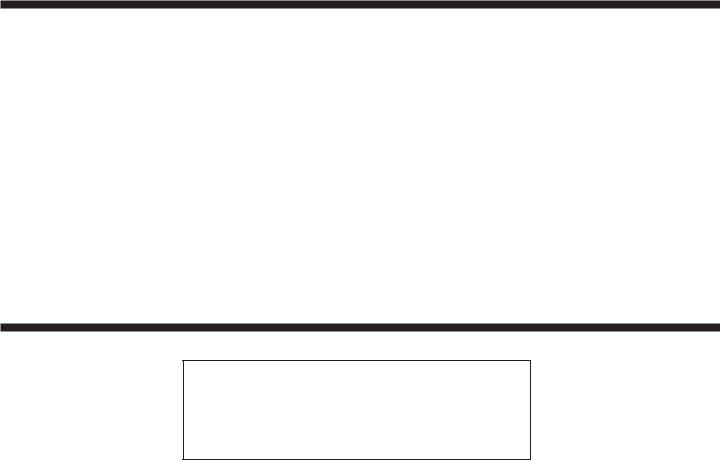
CONTENTS |
|
GRAPHIC WARNINGS .................................................................................................................................. |
2 |
SAFETY PRECAUTIONS ............................................................................................................................... |
3 |
DEFINITION OF TERMS ............................................................................................................................... |
5 |
CURVED SHAFT MODELS — CLOCKWISE ROTATION ......................................................................... |
6 |
STRAIGHT SHAFT MODELS — COUNTERCLOCKWISE ROTATION ................................................... |
7 |
PROTECTIVE DEVICES ................................................................................................................................ |
8 |
COMBINATION OF CUTTING HEADS, SHIELDS, HANDLES, ETC. ....................................................... |
9 |
RULES FOR SAFE OPERATION ................................................................................................................... |
10 |
CUTTING WITH NYLON LINE .................................................................................................................... |
16 |
CUTTING WITH BLADES ............................................................................................................................. |
21 |
ECHO ATTACHMENTS AND ACCESSORIES ............................................................................................ |
24 |
SAFETY PRECAUTIONS |
|
WARNING  DANGER
DANGER
Read the operator’s manual carefully. Be familiar with the controls and the proper use of the unit. Know how to shut the unit off, and how to unhook a harnessed unit quickly.
•Do not allow a person to use this unit unless instructions are read and understood. Never allow children to operate or play with the unit.
•There is a great risk of eye loss from thrown objects. Always wear qualified eye protection in accordance with ANSI Standard Z87.1.
•Wear proper clothing to protect feet, legs, and other exposed parts of your body. Wear hearing protection devices. Also wear dust masks to filter out pollen and other irritants when deemed necessary.
•Do not wear opened-toed shoes or go barefoot or barelegged. Do not wear loose or dangling clothing, neckties, scarfs, or jewelry which could be caught in the unit or the underbrush.
•Keep people out of the danger zone. This is a circle 15 meters in radius (about 16 paces) around the unit and operator.
•Require any persons outside the 15-meter danger zone to wear eye protection to help protect them from thrown objects.
•If necessary to cut where people or cars could be hit by thrown objects, cut at reduced (slow) throttle speed to reduce the speed of the nylon line or blade, thus reducing the velocity of thrown objects.
•Adjust the handle to a position for comfort and good balance as recommended in this manual.
•Check that the cutting line or blade of the unit is away from your feet and legs.
•Be sure the unit is assembled properly.
•The muffler side of the engine should be away from your body. This is necessary to avoid arm burns.
•The unit is designed to be used while positioned on the right side.
•Always use the appropriate harness, properly worn, when one is provided with the unit. Balance the unit as recommended by adjusting the position of the harness clamp on the shaft. If the unit is not provided with a harness, you can obtain one from your dealer to reduce fatigue from operation.
•Follow instructions in this manual when operating the unit with a blade. The blade can be made of metal or other materials such as rubber or plastic. Do not use this unit as a hammer, lever, crowbar, hatchet or ax. Do not misuse the blade or the unit. Do not raise the line or blade head above your knee height. Your unit is not a pruner, hedge trimmer or chain saw and should not be substituted for these tools.
•When operating the unit with a blade, be sure the blade is attached to the unit as designed, such as with a locknut and cotter pin. Also, be sure the blade unit has a metal debris shield, has either a metal bar handle or a U-handle, and is suspended from a shoulder harness.
3

SAFETY PRECAUTIONS (CONTINUED)
•A bladed unit can kickout, causing serious injury to helpers, bystanders or animals. Keep people and animals at least 15meters (approximately 50 feet) away. Use proper procedures to keep control of the unit.
•The blade can push, pull or kickout, causing the operator to lose his balance or lose control of the unit.
•Keep blades clear of fences, wires, posts, rocks, etc. to prevent kick out and blade damage.
•Do not operate when under the influence of alcohol, medications or substances which can affect your vision, dexterity and judgment. You must be in good physical and mental health in order to operate safely.
•Do not operate where the unit could contact electrical conduits, house wiring, or any power lines.
•Handle flammable fuel with care. Use an approved type can. Do not smoke or bring sparks or flame near the fuel supplies. Use proper fueling procedures as recommended in the operator’s manual.
•Never refuel while the engine is running or hot. Move at least 10 feet from the fueling spot before starting the engine.
•Do not store the unit with fuel in the tank, because a fuel leak could start a fire.
•Do not run the engine indoors or where there is poor ventilation. Engine fumes contain deadly poisonous carbon monoxide.
•Never operate the unit without the proper debris shield and other protective devices in place. Replace damaged or broken debris shields.
•Do not operate a semi-automatic feed type line head if the debris shield is not equipped with a cut-off knife.
•Never operate without good visibility and light.
•Never start the engine if the drive shaft is not in place to prevent the engine from over speeding or the clutch from flying apart.
•For starting position, lay the unit down in a clear area so the line or blade cannot contact the ground or any other obstruction.
•Hold the unit down firmly so you will not lose control during cranking. If not held down properly, the engine could pull you off balance or swing the cutting line or blade into an obstruction of your body.
•Do not crank the engine while the unit is harnessed to you or otherwise suspended above ground level.
•Always keep both hands on the control handles. Do not operate one-handed. Do not hold material you are cutting.
•Keep the unit and attachments in good working condition. Tighten fastening parts at regular intervals. Check the cutting head assembly before each use.
•After shutting down the engine, keep fingers and feet away from the cutting line or blade until all rotation stops. If the cutting head coasts for a long time instead of stopping right away, adjust the carburetor per instructions in your operator’s manual, or have the adjustment made by your ECHO servicing dealer.
•Shut down immediately if the unit starts to shake or vibrate. This could be a sign of danger from a broken part or missing fasteners.
•Disconnect spark plug wire before you work on the unit or leave it unattended.
•Do not cut with dull blades which can increase the risk of kickout and breakage.
Before operating unit, thoroughly inspect blades for damage and cracks. Do not use a damaged blade.
•Replace dull 80-tooth Brush Blades if you cannot have them sharpened professionally. Do not try to resharpen them yourself.
•Sharpen dull 8-tooth Grass/Weed Blades at the proper angles with a flat file. Do not file down into the gullet (bottom) are of the tooth. The gullets must be rounded, with no sharp corners or filing nicks which could be the start of stress cracks and blade failure.
•ECHO may produce new design attachments and blades from time to time. If you purchase such an item, follow the installation, operation and maintenance instructions supplied with it.
•Do not mount any ordinary circular saw blade, a lawnmower or edge/trimmer blade, or a grinding type cut-off wheel on your Grass/Weed Trimmer or Weed/Brush Cutter.
•Do not use any blade or attachment not authorized for your unit by ECHO, Inc.
•All maintenance given in the operator’s manual should be performed by you or an ECHO servicing dealer. Any service or repair work for which the operator’s manual does not give instructions must be done only by an authorized ECHO servicing dealer.
•The debris shield, also known as a cutting attachment shield, located at the lower rotating head, is intended to reduce the chance of thrown objects hitting the leg. Do not rely on the debris shield to protect the eyes from thrown objects. Wear eye protection goggles conforming to the ANSI Z87.1 Safety Standard (Z87 is stamped on the goggles).
•Secure hair above shoulders.
•Never use wire or wire rope in place of nylon monofilament cutting line.
•Spark arrester mufflers are standard on ECHO units to reduce the possibility of forest fires. Do not operate the unit with a loose or defective muffler. Do not remove the spark arrester screen.
4

GLOSSARY
ANSI Z87.1 - The established standard for eye protection devices, set forth by the American National Standards Institutes (ANSI).
BARRIER - A device, such as a bar handle, U-handle or harness, which restrains the unit’s cutting attachment from moving rearward and making inadvertent contact with the operator’s legs.
BLADE RETAINER - A mechanism which holds the brushcutter blade to the driving member.
BLADE THRUST - Another name for Kickout.
BOUNCE - The ricochet of a flying object from any surface, particularly from the ground, rocks or buildings.
BRUSH BLADE - A multi-tooth circular saw blade for sawing heavy brush with SRM models only.
CUTTING CIRCLE - The blade perimeter or the circle formed by a cutting line.
CUTTING HEAD - The assembly that includes the flexible cutting line or a blade. Flexible cutting line heads include:
•BUMP-ADVANCE HEAD - Extends the line through a bumping mechanism.
•CENTRIFUGAL-ADVANCEHEAD-Extendstheline through speed changes.
•MANUAL HEAD - A flexible line suspension mechanism requiring manual adjustments of the line length.
DANGERZONE-A15-meter(orapproximately50-foot)radiussurround- ing the operator of the unit. No one else but the operator should be in the Danger Zone while the unit is being used. (See Risk Zone.)
DEBRIS SHIELD - The shield just behind the cutting head. Also called a cutting attachment shield.
DEFLECTION - A glance, or bounce, or change of path of a thrown object off a hard surface.
EDGING - Trimming the grass along an edge such as a sidewalk.
FACE MASK - A mask to shield face from flying objects. Face masks alone do not provide adequate protection. Eye protection goggles meeting ANSI Standard Z87.1 must be worn underneath. (See “GOGGLES.”)
FACE SHIELD - A device worn in front of the eyes and a portion of, or all of, the face to supplement protection afforded by a primary protective device. Face shields alone do not provide adequate protection. (See “GOGGLES.”)
GOGGLES - A device covering eyes and sockets, flush against the face, having impact-resistant lenses. Such goggles must meet the ANSI Z87.1 Standard (“Z87” is stamped on the goggles).
GT - Grass Trimmer
GRASS TRIMMER - A grass and weed-cutting unit with a nylon line cutting head. Not to be used with a metal blade.
HARNESS - The adjustable strapping by which the unit is suspended from the operator. A SHOULDER/WAIST HARNESS must be worn by the operator when the unit is equipped with a blade for cutting. A SHOULDER HARNESS when blade-cutting with a bar handle or U- handle is acceptable. Also, it is advisable to wear a harness when using a flexible line trimmer to help reduce fatigue.
HEARING PROTECTION - Ear muff or plug-type devices worn to reduce exposure to harmful noise while permitting an operator to hear certain sounds.
HIT - When a thrown object hits someone or something and is capable of injury or penetration.
IMPACT SPEED - The speed of a striking object.
IMPACT ENERGY - The energy from a thrown object that is transferred to another object or person during impact.
HANDLES:
•BAR HANDLE - A straight metal handle, standard on some SRM units.
•D-HANDLE - A looped handle.
•U-HANDLE - Has the configuration of a U-shaped bicycle handle bar which reduces the working effort compared to a D-handle.
KICK OUT - When the unit dangerously propels itself out of a cut due to blade binding. The direction is opposite the blade rotation at point of contact. (See page 22.) Also called Blade Thrust.
MAXI-CUTWEEDCUTTER-A3-bladeflail-typedevicewhichcan be used in place of the nylon line head.
PUSH & PULL - Forces exerted by the blade. If the blade pulls, the unit will pull away from the operator. If the blade pushes, the unit pushes back towards the operator. (See page 22.)
QUICK-RELEASEMECHANISM-Amechanismcontrolledbythe operator to quickly release the unit from the harness in case of emergency.
RICOCHET - A thrown object which glances off a surface and takes a new path.
RISK ZONE - The area beyond the 15-meter (or approximately 50foot) radius surrounding the operator of the unit. Bystanders in the Risk Zone should wear eye protection against thrown objects. Risk diminishes with distance from the operator. (See Danger Zone).
SRM - Shoulder Rotary Mower
SHOULDER ROTARY MOWER - A flexible-line grass and weedcutting unit which can be converted for use with a blade.
SCALPING - The very close cutting of vegetation from the earth. A trimmer is used to clear growth around trees or shrubs, or from sidewalks.
SCYTHING - An arcing motion to cut weeds by swinging the tool head from side to side.
GLOSSARYCONTINUEDONNEXTPAGE
5
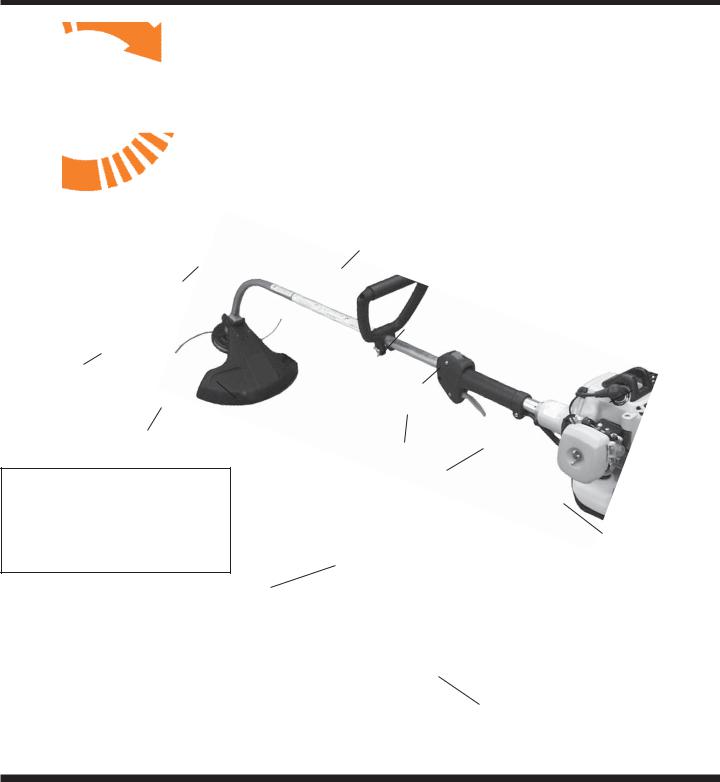
CURVED MODELS
GT SERIES
D-HANDLE
GRASS/WEED |
CURVED |
|
|
TRIMMERS |
SHAFT |
|
|
|
|
SWITCHON |
|
|
|
MOSTMODELS |
|
SINGLEORDOUBLEFEED |
|
STARTER |
|
|
GRIP |
||
NYLON LINE HEAD |
LINECUT-OFFKNIFE |
MUFFLER |
|
ACCORDINGTOMODEL |
COVER |
||
ON RIGHT SIDE OF |
|||
|
|
||
|
DEBRISSHIELD |
|
DEBRISSHIELD
THROTTLE
LEVER
WARNING  DANGER
DANGER
DO NOT INSTALL
A METAL BLADE
ON A GT UNIT.
SWITCHISONENGINE
ONSOMEMODELS
FUEL CAP
SHOULDERHARNESS
(STANDARD ON
SOMEMODELS)
ASSEMBLY TOOLS
GLOSSARY (CONTINUED)
STRESS CRACK - Structural damage resulting from misfiling of blade teeth, pinching in a cut or using the blade as a lever.
TIP SPEED - The speed of the cutting line or blade (in mph or fpm) at the perimeter of the cutting circle.
THROWN OBJECT - A projectile propelled from flexible cutting line or a blade capable of causing bodily injury to the operator or bystanders.
TRIMMER - A GT or SRM unit when fitted with a line cutting head or Maxi-Cut Weed Cutter. Metal blades are recommended only on SRM units with special conversion kits.
UNIT - Powerhead, shaft and cutting assembly.
U-HANDLE - Has the configuration of a bicycle handle bar to reduce working effort compared to a D-loop handle.
WEED/GRASS BLADE - A blade to cut heavy grass and weeds.
6
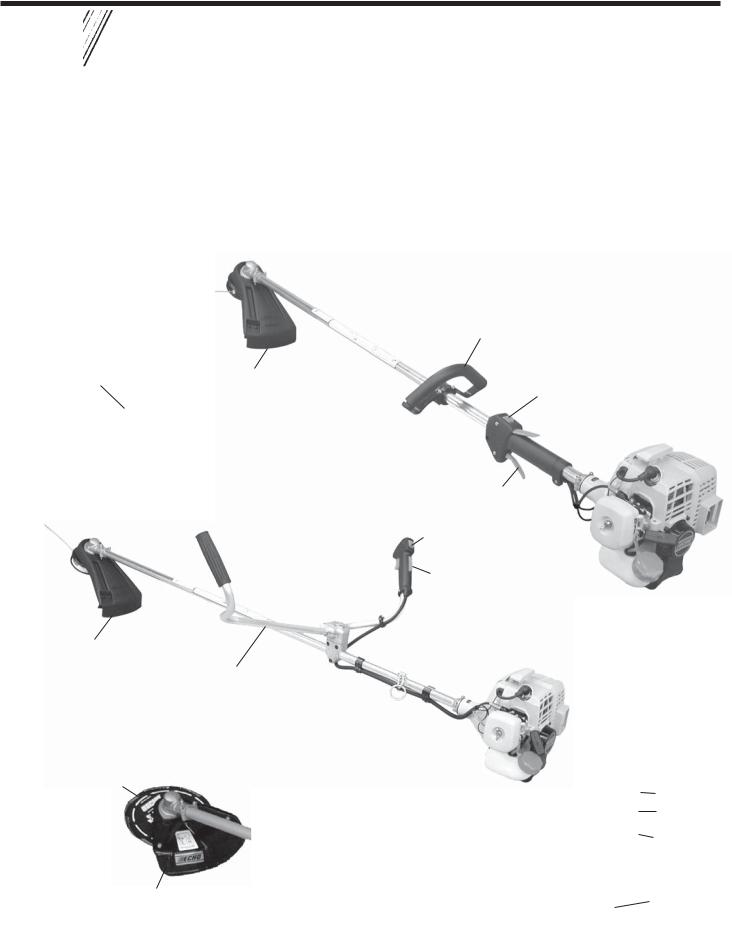
STRAIGHT SHAFT
MODELS
SRM SERIES
GRASS/WEED/BRUSH CUTTERS
SHOULDER ROTARY MOWERS CONVERTIBLE FOR METAL BLADE USE
D-HANDLE ON SOME MODELS IS SUITABLE
FOR NYLON LINE TRIMMING, BUT MUST BE
REPLACED WITH A U-HANDLE IF METAL
BLADES ARE TO BE USED
DEBRISSHIELD
STOPSWITCH
SHOULDER/WAIST
HARNESS
THROTTLE
LEVER
STOPSWITCH
THROTTLE
LEVER
DEBRISSHIELD
U-HANDLEREQUIRED
FOR USE WITH METAL BLADES
IS STANDARD ON THE LARGER
SRMMODELS
OPTIONAL
BLADE
BLADE ADAPTER
NUT
PACKAGE OF COTTER
PINS
METALDEBRISSHIELD
FOR USE WITH METAL ASSEMBLY TOOLS
BLADES
7
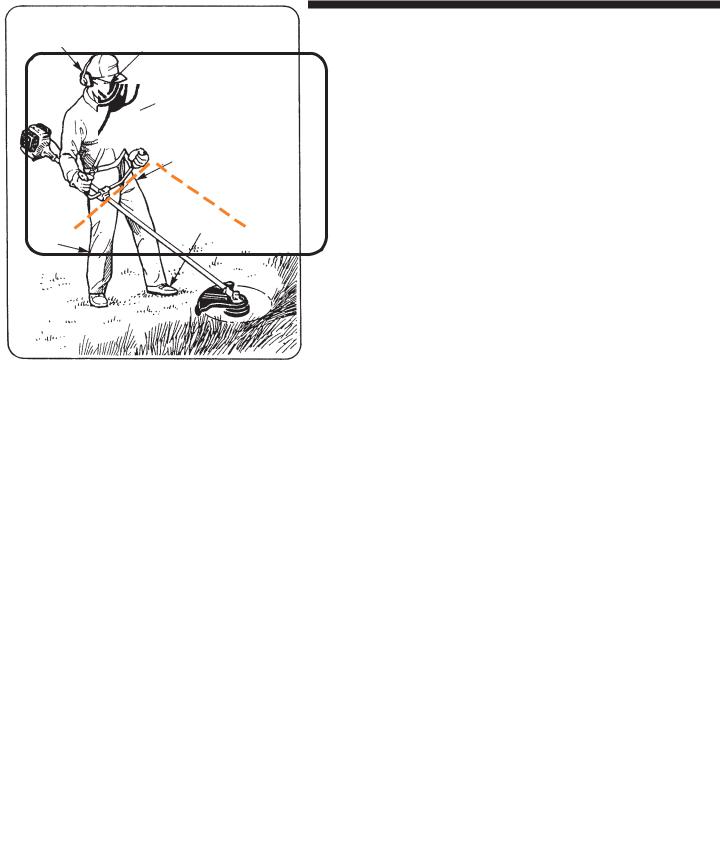
PROTECTIVE DEVICES
TO BE WORN BY OPERATOR
WEAREYE/EARPROTECTION
 AGAINST HITS FROM EVERY DIRECTION
AGAINST HITS FROM EVERY DIRECTION
DESIGNSCONFORMING
TO ANSI Z87.1
GOGGLES
*FACESHIELD
*DANGER: USE GOGGLES UNDER FACE SHIELD
HEARING
PROTECTORS SAFETY
GOGGLES
SHOULDER
HARNESS
TRIM-FITTING
CLOTHES
STURDY SHOES OR
BOOTS
LONG
PANTS
EYE AND FACE PROTECTION
At the minimum, the operator must wear eye approved protection, not only against objects thrown by the unit, but also because eye infections can be caused by airborne dust, seeds and pollen.
ECHO safety goggles are stamped Z87 as being in compliance with ANSI Standard Z87.1 for eye protection devices. Prescription glasses may be worn under the safety goggles. Eye protection should also be worn by persons in the risk zone which extends beyond the danger zone. (See pages 8-11.)
If operating conditions require additional face protection, flip-down face shields in conformance with ANSI Standard Z87.1 are also available. The face shields may attach to a safety “hard hat”. Safety goggles must be worn underneath.
HEARING AND EAR PROTECTION
ECHO recommends wearing hearing protection at all times. If not followed, hearing loss can occur after frequent and lengthy exposure to engine noise. You should reduce the risk of hearing damage by wearing with “headset” type protectors or approved ear plugs. “Head sets” may also prevent ricocheted objects from entering the ears.
PROTECTIVECLOTHING
Choose pants, shirts and jackets that fit trimly and have no strings, frills or dangling straps which could catch on the unit or the underbrush. Do not wear ties, loose clothing or jewelry. Keep clothing buttoned or zipped up and shirt tails tucked in.
The wearing of gloves offers some protection against contact with skin irritants such as poison ivy. Soft leather work gloves may also improve your grip.
FOOT AND LEG PROTECTION
Long pants and sturdy shoes with non-slip soles are generally acceptable protection against objects thrown by a nylon line trimmer. For heavy brush cutting with metal blades, logger’s pants or leg chaps with protective inserts and adequate protective boots are an added consideration.
ADDITIONAL PROTECTION
Hay fever (rhinitis) sufferers may purchase disposable masks at hardware or medical supply stores to help reduce the intake of allergenic particles.
8
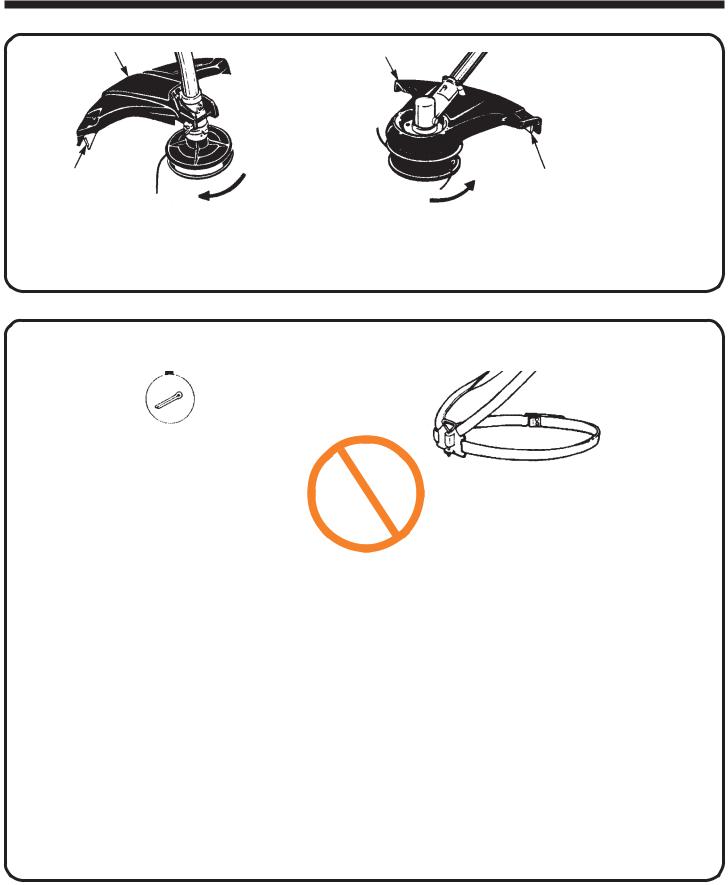
COMBINATIONS OF CUTTING HEADS, SHIELDS, HANDLES, ETC…
PLASTICDEBRISSHIELD |
PLASTICDEBRISSHIELD |
|
WHENPROVIDEDFOR |
||
FOR CURVED SHAFT UNITS |
||
STRAIGHT SHAFT UNITS |
||
|
CUT-OFFKNIFE CUT-OFFKNIFE ONLEFTSIDE ONRIGHTSIDE
DEBRIS SHIELDS FOR NYLON LINE HEADS
BASIC COMPONENTS AVAILABLE FOR METAL BLADE USE
REVIEW THE OPERATOR’S MANUAL FOR PROPER PROCEDURE WHEN CONVERTING FROM NYLON LINE HEAD TO
BLADE APPLICATION
2.IF UNIT HAS A D-HANDLE, REPLACE
WITH A BAR OR U-HANDLE
BAR HANDLE
1.IF UNIT HAS A PLASTIC DEBRIS SHIELD, REPLACE WITH METAL BLADE SHIELD. SEE
OPERATOR’S MANUAL.
U-HANDLE
3.SELECT AND INSTALL THE BLADE OF YOUR CHOICE.*
4. INSTALL THE SHOULDER/ WAIST HARNESS.
BLADE MUST BE RETAINED |
|
|
|
WITH A NEW COTTER PIN |
|
|
|
|
|
||
EACH TIME INSTALLED. |
WARNING |
DANGER |
|
|
|||
|
DO NOT INSTALL |
||
* CHECK DEALER FOR NEW CUTTING BLADES |
A METAL BLADE |
||
OR HARNESSES WHICH MAY BE INTRO- |
ON A GT UNIT. |
||
DUCED FROM TIME TO TIME |
|||
|
|
||
|
|
|
|
9
